
Basic Bass Guitar Lessons
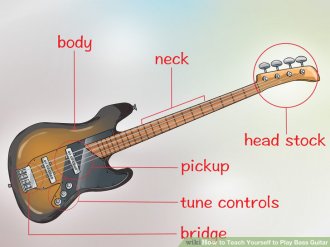 Familiarize yourself with the anatomy of the bass. Identify the most important parts of the bass.
Familiarize yourself with the anatomy of the bass. Identify the most important parts of the bass.
Learn proper posture, how to hold the bass while standing and sitting. Adjust the strap so that playing feels comfortable. Place your right hand above the strings. You may rest the lower arm on the bass. Find a position along the strings where the sound is full between the fretboard and the other end.
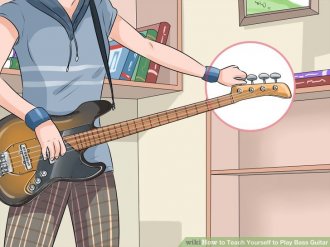 Learn how to pluck the bass. Use the index and middle fingers of your right hand to pluck the strings. Try to isolate the plucking to your fingers, thereby minimizing wrist and arm movement. Learn how to alternate between index and middle fingers. Practice switching between strings in a I-M-I-M pattern where I is index finger and M is middle finger. You may use your thumb as support on the back side of the bass.Alternatively, you may wish to learn to play the bass with a pick. If this is the case, buy a heavy gauge guitar pick. Hold the pick between your index finger (between the first and second knuckles) and your thumb. Then pluck the string by moving the pick downward across it and then upward across it. Practice this down-up plucking motion. If you are unsure as to which technique is best for you, try both.
Learn how to pluck the bass. Use the index and middle fingers of your right hand to pluck the strings. Try to isolate the plucking to your fingers, thereby minimizing wrist and arm movement. Learn how to alternate between index and middle fingers. Practice switching between strings in a I-M-I-M pattern where I is index finger and M is middle finger. You may use your thumb as support on the back side of the bass.Alternatively, you may wish to learn to play the bass with a pick. If this is the case, buy a heavy gauge guitar pick. Hold the pick between your index finger (between the first and second knuckles) and your thumb. Then pluck the string by moving the pick downward across it and then upward across it. Practice this down-up plucking motion. If you are unsure as to which technique is best for you, try both.
Learn how to mute strings with each of your hands. When learning how to play bass, ideally a string should never vibrate with another.
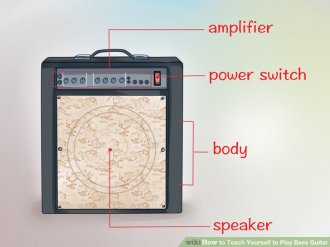 Get into position. Place your both hands on the bass and try to become as comfortable with your left hand as possible in the direction of the tuning pins of the bass. With your left hand place your index finger on the first fret and your other fingers on adjacent frets.
Get into position. Place your both hands on the bass and try to become as comfortable with your left hand as possible in the direction of the tuning pins of the bass. With your left hand place your index finger on the first fret and your other fingers on adjacent frets.
Learn the notes of the first four fingers of the most upper string including the loose string note: (E) F F# G G#. Continue for each string A (A# B C C#), D (D# E F F#) and G (G# A A# B).
Learn how to press the strings with your left hand hard enough so that when you pluck with your other hand the pitch will shift accurately. Avoid the sound of loose left hand fingers.
10
Learn how to play in time. Use a metronome. First, try playing notes using the open E string on each beat of the metronome. These are called quarter notes. Start slowly and gradually speed up the tempo (or speed at which the metronome clicks) as you become comfortable playing in time. Then, start slowly again and attempt to play on each click of the metronome (or beat), as well as once halfway between each beat. These are called eighth notes. Finally, start slowly again, and attempt to play one note on each beat, halfway between each beat, and halfway between each of these. That is to say your first note should line up with a click of the metronome, and you should play three more notes before you hear the next click. These are called sixteenth notes. Be sure to keep each note even with all the others at each step.
11
Learn how to read and play bass tablature. Look for beginners tablature on the internet.
12
13
Learn how to play the E major scale. This is all of the notes in the key of E and is the easiest scale on the bass. Play the E string open, then the E string on the second fret, the E string on the fourth fret, the open A string (or the E string on the fifth fret, as they are the same note), the A string on the second fret, the A string on the fourth fret, the D string on the first fret, and finally the D string on the second fret. Then try going back down the scale and up again until you are comfortable with it. Then, you can learn other scales by playing higher. For instance, the F major scale is the same pattern, you just play each note one fret down the neck (E string first fret, E string third fret, E string fifth fret, A string first fret, etc.). The F# major scale will be two frets down, the G major scale will be three frets down, and so forth.
14
Learn the role of the bass player in a band. The bassist is often thought of as the liaison between the drummer and the rest of the band. This is due to the fact that the bassist is heavily involved in setting the beat of a song, as well as often forming the root of the chords the rest of the band are playing. Thus, you should work very closely with the drummer and work together to keep the tempo.
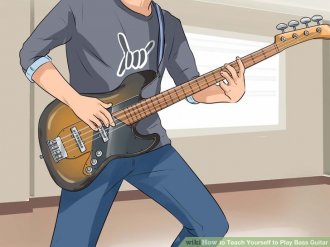
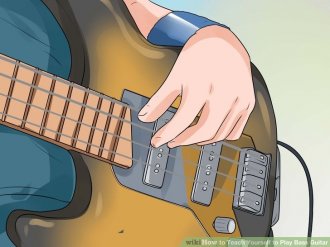
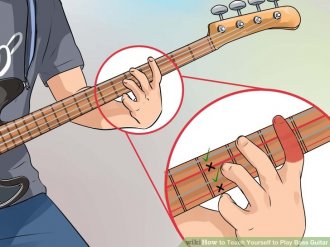
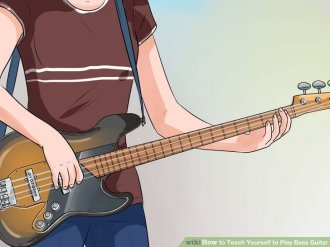
YOU MIGHT ALSO LIKE



Share this Post
Related posts
Download Bass Guitar Lessons
The rite of passage for members of the Satere-Mawe tribe of Brazil requires wearing a glove filled with bullet ants, whose…
Read MoreFirst Bass Guitar Lessons
Gunther swung open my office door with a violent jolt and glared at me jealously. He wasn’t amused to see me sitting on the…
Read More










